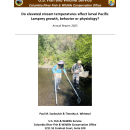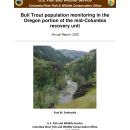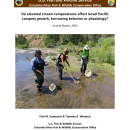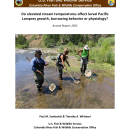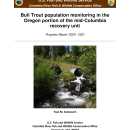
1211 SE Cardinal Ct
Suite 100
Vancouver, WA 98683
United States
About Paul Sankovich
Paul is currently working on projects aimed at evaluating the presence/absence of Bull Trout and Pacific Lamprey in northeast Oregon streams; the use of eDNA as a sampling technique to determine Pacific Lamprey occupancy; the impacts of elevated stream temperatures on Pacific Lamprey survival, growth, and burrowing behavior; and the passage of Bull Trout at a FWS-funded Chinook Salmon hatchery weir. Paul also works on monitoring projects for Bull Trout and freshwater mussel populations in northeast Oregon streams. Paul is a member of six Bull Trout Recovery Unit Implementation Plan working groups and regularly provide support for ES staff in Oregon and eastern Washington.
Program: Natural Population Assessment
Current Projects:
Planning and implementation of Bull Trout and Pacific Lamprey occupancy and distribution in Northeast Oregon streams
Engage in working groups for Bull Trout recovery efforts in core areas of Eastern Oregon and evaluation of Bull Trout passage at weirs along the Imnaha and Tucannon rivers
Evaluating eDNA as a technique to determine Pacific Lamprey occupancy
Planning and implementing monitoring activities for Bull Trout populations in the Oregon portion of the Mid-Columbia recovery unit
Past Projects:
Identification of factors limiting Bull Trout production in Umatilla Basin and John Day Basin
Background: Paul has been with FWS since 2004 and worked primarily on studies focused on identifying factors limiting Bull Trout production in the Umatilla and John Day River basins in northeast Oregon. Before joining the FWS, Paul conducted fisheries research for the Idaho Cooperative Fish and Wildlife Research Unit (1989-1992), Idaho Department of Fish and Game (1992-1995), and Oregon Department of Fish and Wildlife (1995-2004). Paul participated in studies relating to the spawning behavior of hatchery- and naturally-produced Chinook Salmon, the life history and behavior of Snake River summer Steelhead and spring-summer Chinook Salmon, the production of Chinook Salmon and Steelhead in hatcheries, the supplementation of wild Chinook Salmon populations with hatchery fish; and the life history, genetics, and habitat requirements of bull trout. Paul also worked on projects evaluating methods of estimating the abundance of adult Bull Trout and assessing the use of captive brood stocks to assist in the recovery of Snake River spring-summer Chinook Salmon.
At CRFWCO since: 2004
